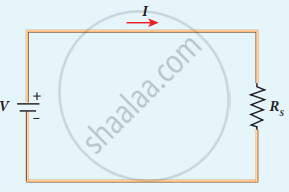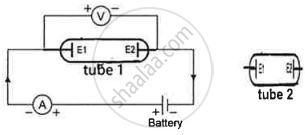Advertisements
Advertisements
प्रश्न
Explain the equivalent resistance of a series resistor network.
उत्तर
When two or more resistors are connected end to end, they are said to be in series. The resistors could be simple resistors or bulbs or heating elements or other devices. Fig. (a) shows three resistors R1, R2 and R3 connected in series.

Three resistors in series
The amount of charge passing through resistor R1 must also pass through resistors R2 and R3 since the charges cannot accumulate anywhere in the circuit. Due to this reason, the current I passing through all the three resistors is the same. According to Ohm’s law, if same current pass through different resistors of different values, then the potential difference across each resistor must be different. Let V1, V2 and V3 be the potential difference (voltage) across each of the resistors R1, R2 and R3 respectively, then we can write V1 = IR1, V2 = IR2 and V3= IR3. But the total voltage V is equal to the sum of voltages across each resistor.
V = V1 + V2 + V3
= IR1 + IR2 + IR3 ….. (1)
V = I(R1 + R2 +R3)
V = I.RS …… (2)
where Rs = R1 + R2 R3 ……. (3)
When several resistances are connected in series, the total or equivalent resistance is the sum of the individual resistances as shown in the following figure.

Equivalent resistance (RS) has the same current
APPEARS IN
संबंधित प्रश्न
Write the SI unit of resistivity
The graph between V and I for a conductor is a straight line passing through the origin.
Which law is illustrated by such a graph?
The graph between V and I for a conductor is a straight line passing through the origin.
What should remain constant in a statement of this law?
Show by a diagram how two resistors R1 and R2 are joined in parallel. Obtain an expression for the total resistance of the combination.
Define ampere and volt with respect to Ohm’s law.
An ammeter placed in series with an electric radiator reads 0.5 amps and a voltmeter placed across it reads 230 volts. What is the resistance of the radiator?
The temperature of a conductor is increased. The graph best showing the variation of its resistance is:
A student carries out an experiment and plots the V-I graph of three samples of nichrome wire with resistances R1, R2 and R3 respectively. Which of the following is hue?

The heat produced by a 100 w heater in 2 minute is equal to
The circuit depicted in the figure is employed for studying Ohm's Law. Instead of using a standard resistor, a student opts for a glass tube filled with mercury (tube 1), connected to the circuit through two electrodes E1 & E2. He records the readings of the ammeter and voltmeter, thereby calculating the resistance. The student repeats the experiment by substituting tube 1 with tube 2, where the same amount of mercury fills the tube 2.

Neglecting internal resistance of the cell use (> or < or =) to compare
- the resistance in both the cases.
- the voltmeter readings in both the cases.
- the specific resistance in both the cases.
